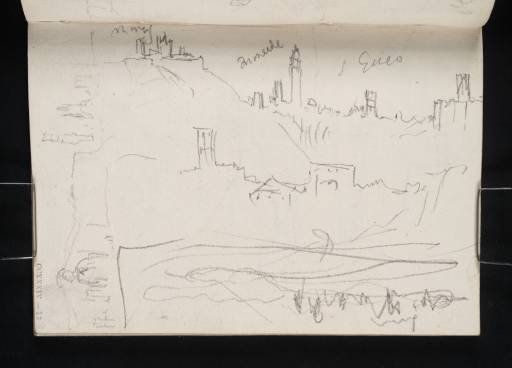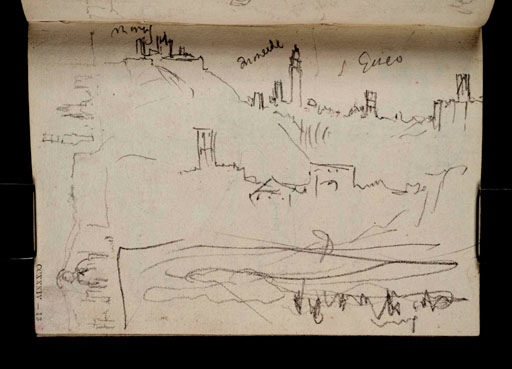Joseph Mallord William Turner The Siena Skyline, with the Cathedral of Santa Maria Assunta and the Torre del Mangia 1828
Image 1 of 2
Joseph Mallord William Turner,
The Siena Skyline, with the Cathedral of Santa Maria Assunta and the Torre del Mangia
1828
Folio 13 Recto:
The Siena Skyline, with the Cathedral of Santa Maria Assunta and the Torre del Mangia 1828
D21612
Turner Bequest CCXXXIV 13
Turner Bequest CCXXXIV 13
Pencil on paper, 104 x 148 mm
Inscribed in pencil by Turner ‘[?Mary]’, ‘[?mangia]’ and ‘St [?Gueo]’ across top, and ‘[L...]’ bottom right, upside down
Stamped in black ‘CCXXXIV – 13’ bottom left, descending vertically
Inscribed in pencil by Turner ‘[?Mary]’, ‘[?mangia]’ and ‘St [?Gueo]’ across top, and ‘[L...]’ bottom right, upside down
Stamped in black ‘CCXXXIV – 13’ bottom left, descending vertically
Accepted by the nation as part of the Turner Bequest 1856
References
1909
A.J. Finberg, A Complete Inventory of the Drawings of the Turner Bequest, London 1909, vol.II, p.718, CCXXXIV 13, as ‘Do. [i.e. ditto: towers, &c.] “Moneide” (?); also “S. Queo” (?), &c.’.
This page contains several rough studies of Siena, executed with the sketchbook turned in different positions. Dominating the page is a panoramic view of the city from the south, which Turner composed with the sketchbook turned horizontally. It appears to have been divided in half, running over onto a second level below.
Across the upper section, the landmark to the left is labelled ‘Mary’, referring to the city’s Cathedral of Santa Maria Assunta. Its elaborate arched façade in the Gothic style is reduced here to a schematic outline. The prominent tower to the right is presumably the Torre del Mangia, a fourteenth-century civic tower overlooking the main square, the Piazza del Campo. The accompanying inscription is partly illegible, but may be a variation of ‘mangia’. For a more detailed depiction of the Torre del Mangia, see folio 11 recto (D21608). The third inscription to the right is difficult to make out; in his 1909 Inventory of the Bequest, Finberg tentatively proposed ‘S. Queo’.1 The lower tier of buildings, featuring a tower and arch, is more difficult to identify due to the lack of inscriptions. Turner produced a similarly labelled skyline of Siena later in the sketchbook on folio 18 recto (D21622).
At the bottom of the page is a rough study of a tree-lined landscape, appearing upside down relative to the skyline above. The location and accompanying inscription are unclear. In the left margin, inverted relative to the sketchbook’s foliation, is a faint outline of a gateway in Siena’s medieval walls. It is likely the Porta Camollia, which traditionally guarded the northern part of the city and served as the main point of entry from Florence to the north, especially for pilgrims travelling along the Cassia Way.2 Presumably, it also afforded Turner his first glimpse of Siena. The original thirteenth-century gate was destroyed during the Siege of Siena in 1555, and the version sketched here by Turner dates back to 1604.3 See folio 14 recto (D21614) for an enlarged detail of the Medici coat of arms, possibly above the Porta Camollia.
For further commentary on Turner’s first visit to Siena in 1828, together with a list of relevant works in the sketchbook, see under folio 10 verso (D21607).
Hannah Kaspar
November 2024
‘Porta Camollia gate and Fortino delle donne fort’, Visit Siena, accessed 24 June 2024, https://visitsienaofficial.it/en/porta-camollia-gate-and-fortino-delle-donne-fort/ .
How to cite
Hannah Kaspar, ‘The Siena Skyline, with the Cathedral of Santa Maria Assunta and the Torre del Mangia 1828’, catalogue entry, November 2024, in David Blayney Brown (ed.), J.M.W. Turner: Sketchbooks, Drawings and Watercolours, Tate Research Publication, February 2025, https://www


